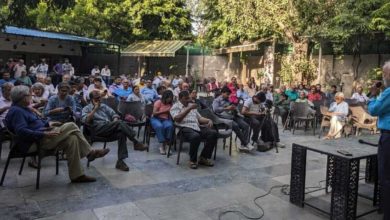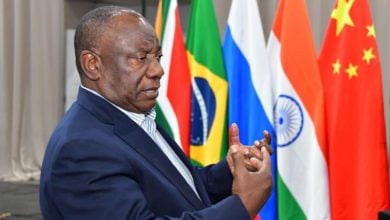U.S. military planners are facing increasing challenges to their goal of occupying Central Asia. On July 5, the Shanghai Cooperation Organization—China, Russia, Kazakhstan, Uzbekistan, Kyrgyzstan and Tajikistan—called on the United States to set a timetable for withdrawal of its troops from the region.
Then, on July 30, Uzbekistan handed the U.S. armed forces an ultimatum. The Uzbek government gave the United States 180 days to evacuate its only air base in the country.
Learning of the U.S. eviction from Uzbekistan, chairman of the U.S. Joint Chiefs of Staff Gen. Richard Myers arrogantly called it “not very helpful.”
“Central Asia is important to the United States for lots of reasons, not just for operations in Afghanistan,” Myers said. “Security and stability in Central Asia is an important concept and those that can bring security ought to be welcomed in Central Asia. Uzbekistan is a very important country over there.” General Myers means security and stability for the plunder by U.S. corporations.
The U.S. is desperately scrambling to hold on to its presence in Central Asia. U.S. Defense Secretary Donald Rumsfeld visited Kyrgyzstan and Tajikistan on July 26 to ensure that U.S. bases would remain in those countries. In Kyrgyzstan, Rumsfeld promised a $200 million interest-free loan for the continued use of the base, according to the Asian Times. This is 60 percent of the Kyrgyzstan government’s yearly budget. Rumsfeld also succeeded for the moment in keeping the U.S. refueling base in Tajikistan.
Rumsfeld did not visit Uzbekistan.
Kazakhstan, Uzbekistan, Kyrgyzstan and Tajikistan were four of the 15 full republics that constituted the Union of the Soviet Socialist Republics until the Soviet government was overthrown in 1991 by a U.S.-backed counter-revolution. Pro-capitalist elites took power in these former Soviet Republics and declared their independence. The objective of U.S. foreign policy since 1991 has been to incorporate these countries into a U.S. sphere of influence. The war in Afghanistan provided a pretext for the Pentagon to insist that these countries allow the United States to establish military bases on their soil. Now Russia and the local forces in these countries are resisting U.S. efforts to turn the region into a neo-colonial appendage of the Pentagon.
Oil and U.S. aggression
Shortly after September 11, 2001, the U.S. government secured the use of three air bases in Central Asia to carry out its brutal war on Afghanistan. The Pentagon has one air base each in Uzbekistan, Kyrgyzstan and Tajikistan, with a total of around 5,000 troops. In Afghanistan, the United States has set up a colonial occupation operation complete with 20,000 U.S. troops, a puppet government, and three more large air bases.
In the 14 years since the overthrow of the Soviet Union, U.S. imperialism has moved to increase and extend its influence all over the world. Dozens of additional countries have been forced into its orbit. U.S. corporations have opened up new markets for exploitation in regions previously closed to them.
The new military bases in Eastern Europe, the Middle East and Central Asia are an integral part of U.S. expansion.
The U.S. ruling class has no intention of leaving Central Asia any time soon. The region has vast amounts of untapped natural resources. A permanent foothold in Central Asia places the U.S. military presence not only on the crossroads of the majority of trade routes between Iran, Russia, India and China; it also puts the U.S. military on both China’s and Russia’s doorstep.
Central Asia is rich in oil, natural gas, coal and many other minerals including gold and uranium. In the Caspian Sea region alone, which includes Kazakhstan, Turkmenistan, Uzbekistan, Azerbaijan and parts of Russia and Iran, there are up to 200 billion barrels of oil reserves, according to a 1997 report by the Council on Foreign Relations. This is one-fifth of the world’s oil reserves. Kazakhstan alone has 40 billion barrels of oil reserves.
Along with the Middle East, Central Asia is key to U.S. domination of the world energy markets. China gets over half of its imported energy supply from Central Asia.
Weakening its rivals Russia and China and keeping the two countries apart economically and politically have always been major goals of U.S. political strategists.
To the dismay of Washington and Wall Street, China and Russia have recently moved toward greater cooperation. Later this year, Russia and China will be conducting their first joint military exercises since 1958. In the economic realm, trade between the two countries has jumped from $7 billion in 2003 to $21 billion in 2004, according to a July 8 article by Xinhua News Agency. China and Russia issued a joint statement in early July criticizing U.S. “unilateralism” in the world, according to a July 2 Xinhua report.
Uzbekistan stands up
In December 2004, Uzbekistan closed the office of the United States-based Open Society Institute, an organization funded by billionaire George Soros. Soros has helped fund the “peaceful” coups in Georgia and Ukraine as well as fund right-wing opposition groups in Belarus, Russia and everywhere in the former Soviet Union. Soros was a major player in funding separatist forces that led to the disintegration of the Socialist Federation of Yugoslavia in the 1990s.
Since 1991, the U.S. government has spent almost $3 billion funding opposition groups all over the former Soviet Union, according to the 2005 Federation of American Scientists report, “U.S. Assistance to the former Soviet Union.”
On May 20, the Voice of America reported that State Department spokesman Richard Boucher was threatening to cut off $22 million in badly needed international aid to Uzbekistan. This would amount to a severe economic sanction and extreme hardship and suffering for the people. The U.S. government has been demanding that Uzbekistan open its country to an international investigation of a clash in May between the government and opponents that turned violent. Hundreds of people reportedly died.
Hypocritically, the Bush Administration is using the situation to vilify Uzbekistan. At the same time, the Pentagon is reportedly using its air base in Uzbekistan to torture Afghan resistance fighters.
Uzbek President Islam Karimov said that the U.S. government has “far-reaching geopolitical plans, the final aim of which is to change the balance of power and dominate the Central Asian region” at a July 5 summit of the Shanghai Cooperation Council according to the New York Times. A poor country of 28 million people that relies on international aid to survive, Uzbekistan is attempting to steer a course independent of U.S. imperialism.
“What is behind spreading the rumors, lies and discrediting our state before the international community?” asked the June 14 Uzbek government newspaper, Xalq Solz. “The reason for doing this is that some forces are interested in causing instability in the region and turning it into battlefields. They wish to bring the states in the region, in particular Uzbekistan, under their influence and manipulate them as puppets.”
The Xalq Solz report singled out the role of Robert Freedman, an official from the Washington-based “Freedom House” non-governmental organization. It claimed he had been instrumental in the “Orange Revolution” in Ukraine, and had now turned his efforts toward destabilizing Uzbekistan.
The greater cooperation between China, Russia and Central Asian republics has infuriated the Bush administration and Congress. On June 5, Rumsfeld indicated that China was a military threat to its neighbors. “China has an important decision to make about its goals and its future,” Rumsfeld stated. “China will need to embrace some form of open, representative government.”
 |
Central Asia after the Soviet Union
Hurled onto the free market in 1991 after the overthrow of the Soviet Union, Uzbekistan and the four other Central Asian Soviet Republics have been forced to go it alone against the predatory aims of huge transnational corporations.
Privatization, foreign investment and capitalist restructuring have led to widespread poverty, internal conflict and a ballooning foreign debt in all of Central Asia. In Kyrgyzstan more than 50 percent of the people live below the poverty line. In Uzbekistan, almost 30 percent of the people now live below the poverty line, according to a June 7, 2005 report by the UN Food and Agriculture Organization.
The destruction of the Soviet Union’s planned economy resulted in unprecedented economic decline. In the last 15 years, Uzbekistan is the only one of the five Central Asian republics that has reached the economic output level of 1990. No other republic has reached even 75 percent of the 1990 level.
It has also meant greater penetration of the region’s economies by foreign capital. In Kazakhstan, 70 percent of the oil market is now owned by foreign companies. Tajikistan’s foreign debt is 60 percent of the country’s gross domestic product. Kyrgyzstan’s foreign debt is 90 percent of their Gross Domestic Product.
Increased U.S. imperialist presence in these countries has generated mass resentment. An April 4, 2002 U.S. State Department poll of the region found that the vast majority of people in Central Asia are opposed to the U.S. presence in the region. In fact, the poll revealed the people of Central Asia would have preferred to stay in the Soviet Union.
In March 1991, just months before its break-up, the Soviet Union held a referendum on the continued existence of the Soviet Union itself. With an enormous voter turnout, 77 percent voted to keep the Union. In Central Asia, there was 90 percent voter turnout. In Kazakhstan, 94 percent favored keeping the Soviet Union together.
The 1917 Russian Revolution that led to the formation of the Soviet Union sparked the most sweeping affirmative action program in the history of the world. Before 1917, non-Russian nationalities were harshly oppressed and exploited under the Czarist empire. The revolution’s policy of self-determination for nations, including the right of secession and the Bolshevik Party’s determined struggle against racism and national oppression won over many militant Muslims, national liberation fighters, and the majority of the Central Asian people to the Soviet program of united socialist construction and equality for all. This legacy remained despite a retreat from many of these revolutionary policies under subsequent Soviet governments.
Over the course of the Soviet Union’s existence, Central Asia became an industrial and agricultural powerhouse. National cultures flourished and the relations between nationalities experienced more harmony than at any other time in the region’s history.
The people of Central Asia enjoyed one of the greatest affirmative action programs stretching over decades while they were part of the Soviet Union. Indigenous culture and language rights were affirmed, and the people benefited from a conscious resource allocation designed to overcome the legacy of feudalism, illiteracy and poverty. Compared to their neighbors in Afghanistan, the cultural, economic and education levels enjoyed in the former Soviet republics were astonishingly high. Now as the U.S. government wants to strip these countries of nominal sovereignty by transforming them into U.S. military outposts, there is renewed struggle and opposition.
As the war and occupation of Iraq goes badly for the Pentagon, the Bush administration and the U.S. ruling class are facing more setbacks to their empire around the world. In this precarious situation, they need to maintain their unpopular presence in Central Asia and the Middle East in order to dominate the world’s energy market.






